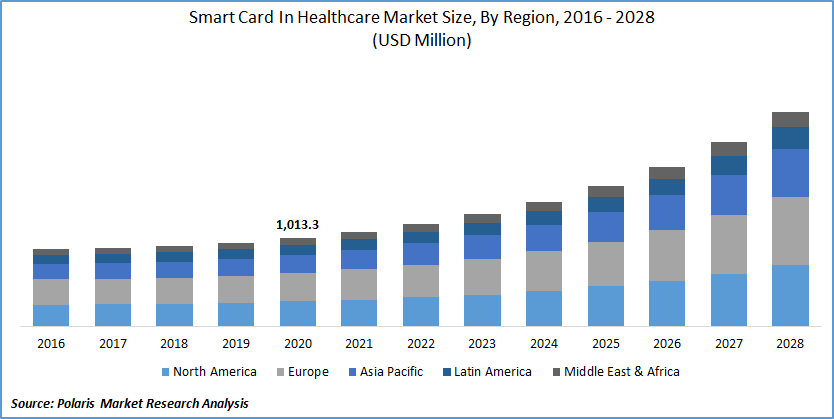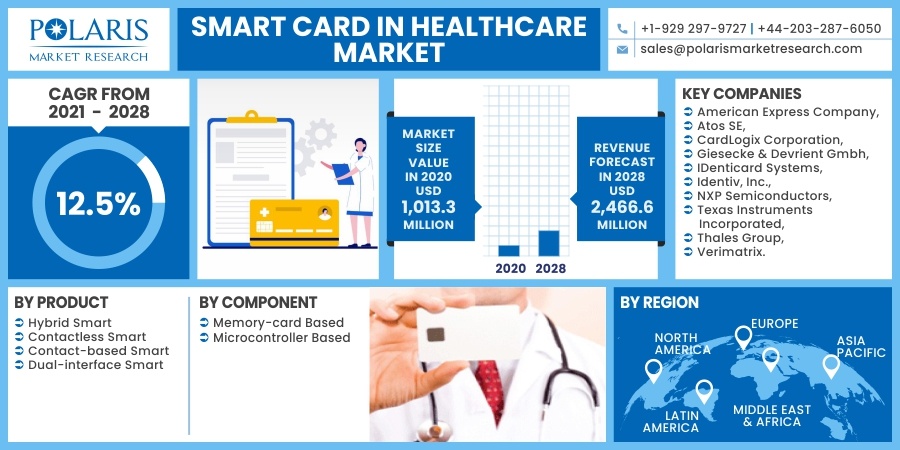
Smart Card in Healthcare Market Share, Size, Trends, Industry Analysis Report, By Product; By Component; By Region; Segment Forecast, 2021 - 2028
- Published Date:Oct-2021
- Pages: 118
- Format: PDF
- Report ID: PM2016
- Base Year: 2020
- Historical Data: 2016 - 2019
Report Outlook
The global smart card in healthcare market was valued at USD 1,013.3 million in 2020 and is expected to grow at a CAGR of 12.5% during the forecast period. The growing need for the contactless and rising pace of digitalization in the healthcare sector has escalated the adoption of the product in the pharmaceutical sector. Furthermore, the outbreak of COVID-19 across the globe has encouraged the adoption of a contactless technology, which is expected to propel the smart card in healthcare market demand.
 Know more about this report: request for sample pages
Know more about this report: request for sample pages
The smart card is a small product that is embedded with an integrated circuit chip, a powerful minicomputer that can be smartly programmed for different applications. This product with embedded chip stores and accesses data and applications securely and further exchanges data securely with readers and other systems. Smart technology has been highly adopted by various hospitals, clinics, and other healthcare infrastructures due to its high security and smart privacy protection levels, making it ideal for handling sensitive information such as identity and personal healthcare information.
Industry Dynamics
Growth Drivers
The sudden outbreak of the coronavirus is the key factor driving the growth of the global market. The drastic changes are occurring due to advancements in the healthcare sector to improve the security and privacy of patient information and cater to the market demand of patients for portable medical records. The market vendors are highly focused on introducing technological advancements in the industry with a secure platform and should be governed by the regulatory standards, thereby creating lucrative growth for the market.
Additionally, the product helps in reducing healthcare frauds, provides secure and real-time access to emergency medical information. According to the National Center for Biotechnology Information, in 2018, the U.S. Department of Justice recorded around 601 defendants charged across 58 federal districts on 165 health care professionals for issuing false billing of opioids and narcotics of approximately USD 2 million.

Know more about this report: request for sample pages
Report Segmentation
The market is primarily segmented based on product, component, and region.
|
By Product |
By Component |
By Region |
|
|
|
Know more about this report: request for sample pages
Insight by Product
The contactless segment dominated the global smart card in healthcare market in 2020, owing to the rising awareness for employee protection, growing adoption of the security of patient's personal information, and the initiatives taken to reduce COVID cases. This product can easily and efficiently be stored securely, and privately patients record numbers assigned by different medical providers that will be used for future medical treatment. Hence, it is highly adopted by various healthcare organizations coupled with growing government initiatives regarding product use fosters market growth over the forecast period.
However, the hybrid-smart segment is projected to grow at the fastest CAGR during the forecast period because they have dual technology. There is continuous improvement in technology for smart cards, which would complement the product market demand in healthcare sector owing to the outbreak of epidemic globally.
Insight by Component
Based on components, the microcontroller-based segment is expected to witness the highest CAGR during the forecast period. These cards are portable and have vast memory, which is highly demanded in the healthcare industry worldwide. Moreover, such a segment is projected to dominate the market's revenue growth by 2028, as people all over the world are actively seeking health cards.
Geographic Overview
Europe is projected to hold the highest revenue share in the global market owing to the fact that rising initiatives by various government and non-government organizations for offering good healthcare facilities across the region. European Union has issued several guidelines regarding the data information, which aims to provide a secured platform for storing patient information, thus, accelerating the market demand for smart cards in the region.
Moreover, the rising COVID-19 cases have emerged the market demand for the contactless smart segment. According to Our World in Data, approximately 881.3 daily new confirmed cases recorder as per million people, as of January 2021, in the United Kingdom. Thus, rising COVID cases in this region escalate the market demand for healthcare smart cards over the study period.
Additionally, France, Germany, Spain, Italy, and United Kingdom (UK) are the countries estimated to record the highest number of COVID cases. Moreover, doctors are concerned about their jobs due to the unawareness regarding the information of the patient's prior medical history. As a result, the EU4Healthcare program launched the "Better Life for Cancer Patients Initiative" by 2022, aiming to offer a cancer survivor smart card that summarizes the patient's healthcare history and facilitates better follow-up, including the patient's own experience.
This personalized and voluntary card will connect the patient with healthcare professionals, thereby improving communication and coordination around medical follow-up. The development of such a platform will be complemented by the 'European Cancer Patient Digital Centre' by 2023. Thus, rising government initiatives for the introduction of smart cards are expected to boost the region's market of healthcare smart cards.
Asia Pacific is expected to witness substantial growth in the global market due to rising medical tourism in the region. Further, the growing technological advancements in healthcare and favorable government initiatives in emerging economies, including China, India, and others, propel the adoption of healthcare cards in the concerned region.
Competitive Insights
The key players operating in the market are American Express Company, Atos SE, CardLogix Corporation, Giesecke & Devrient Gmbh, IDenticard Systems, Identiv, Inc., NXP Semiconductors, Texas Instruments Incorporated, Thales Group, and Verimatrix.
Smart Card in Healthcare Market Report Scope
|
Report Attributes |
Details |
|
Market size value in 2020 |
USD 1,013.3 million |
|
Revenue forecast in 2028 |
USD 2,466.6 million |
|
CAGR |
12.5% from 2021 - 2028 |
|
Base year |
2020 |
|
Historical data |
2016 - 2019 |
|
Forecast period |
2021 - 2028 |
|
Quantitative units |
Revenue in USD million and CAGR from 2021 to 2028 |
|
Segments covered |
By Product, By Component, By Region |
|
Regional scope |
North America, Europe, Asia Pacific, Latin America, Middle East & Africa |
|
Key Companies |
American Express Company, Atos SE, CardLogix Corporation, Giesecke & Devrient Gmbh, IDenticard Systems, Identiv, Inc., NXP Semiconductors, Texas Instruments Incorporated, Thales Group, and Verimatrix. |
